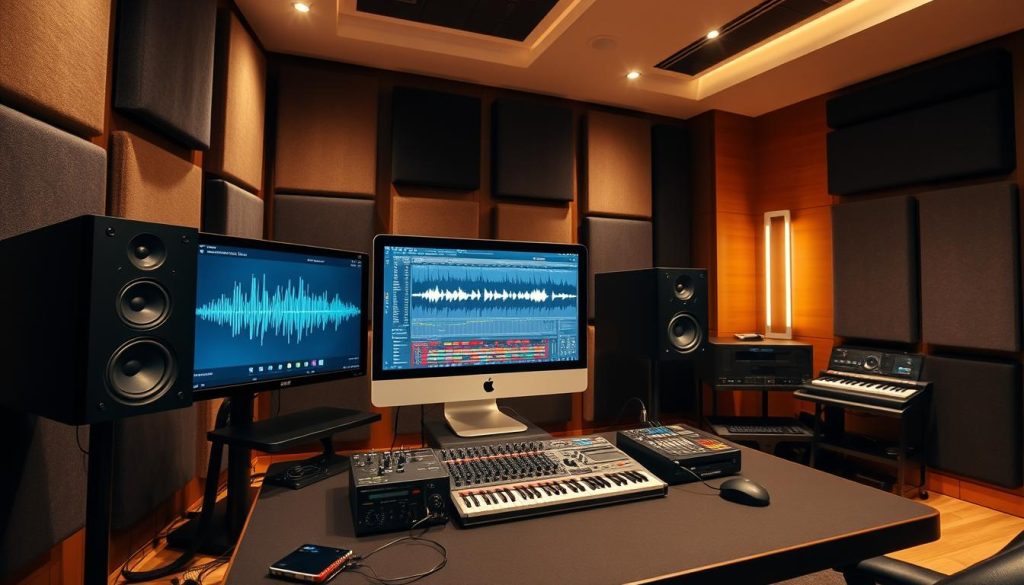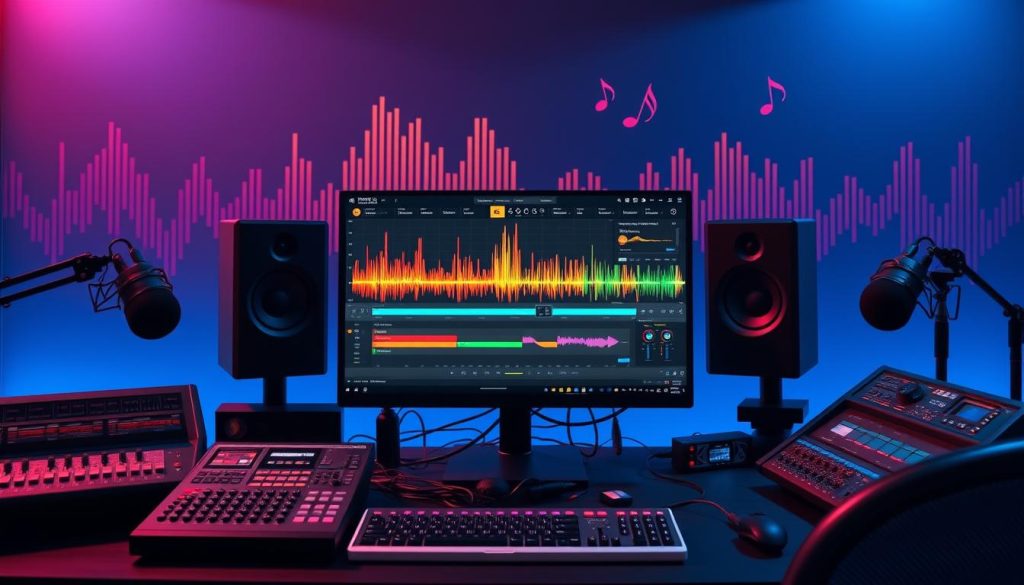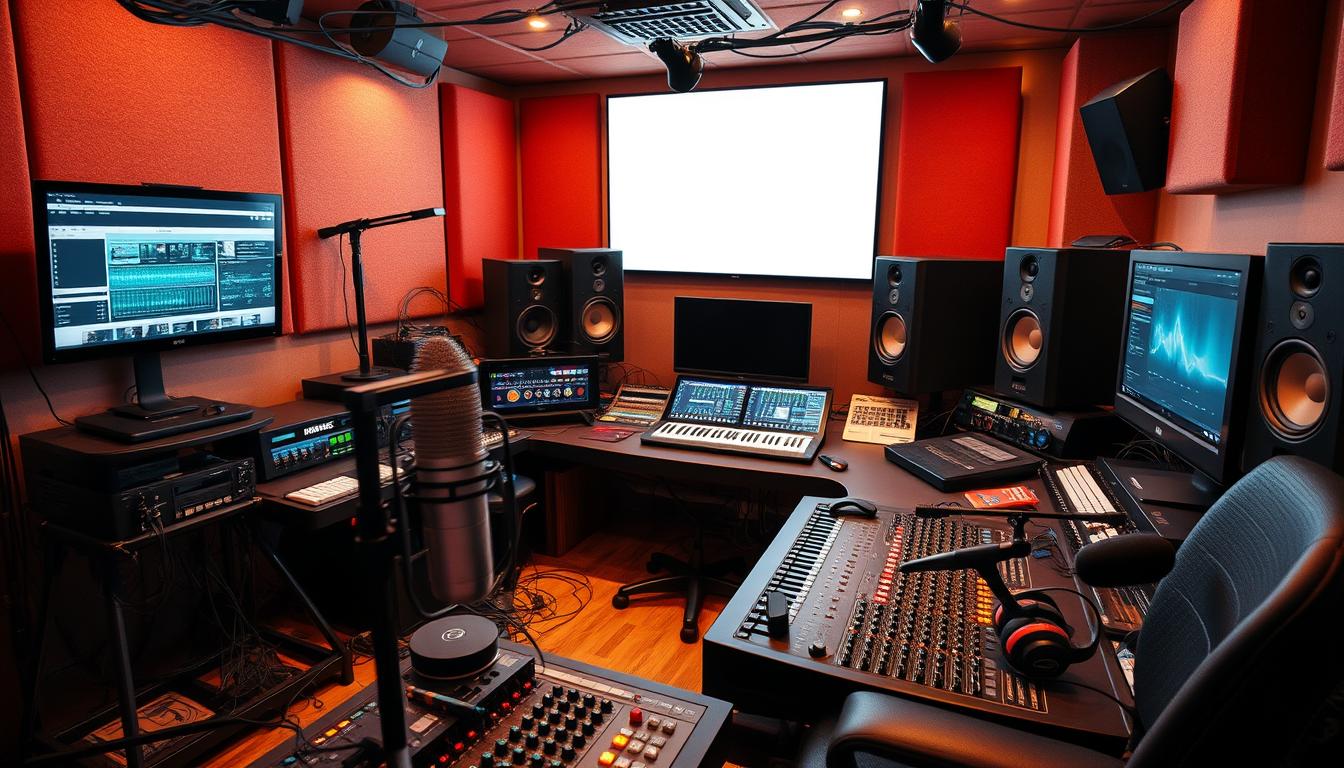I love music and want to be a sound engineer. I’ve learned how important our tools are. Sound engineering uses special equipment, each vital for great sound.
From the first recording to the final mix, the right tools matter a lot. They help make music sound amazing.
I’ll show you the key sound engineering tools pros use. These tools help bring music to life. They’re great for both beginners and those adding to their gear.
Let’s explore the sound engineer’s toolkit. We’ll learn how to make amazing audio experiences.
The Magic of Microphones: Capturing Sound Precision
Microphones are key in sound engineering. They let pros capture the fine details of a performance with great precision. There are many types of microphones, each with special features.
Dynamic Microphones: Versatile Workhorses
Dynamic microphones are loved for their toughness and flexibility. They can handle loud sounds easily. These microphones are perfect for live shows, catching everything from loud drums to strong vocals.
They’re also very durable, making them a must-have for sound engineers.
Condenser Microphones: Capturing Subtleties
Condenser microphones are known for their high sensitivity and accuracy. They’re great at picking up the fine details of music, voices, and background sounds. Their ability to capture subtle sounds makes them popular in recording studios.
Sound engineers use special techniques with microphones. They might use the proximity effect to make vocals sound warmer. Or they might pick lavalier mics for capturing sound without being seen. Knowing how to use dynamic and condenser microphones helps get the best sound.
The Heart of Sound: Mixing Consoles and Audio Interfaces
As a sound engineer, I heavily depend on my mixing console and audio interface. These tools are key to shaping the sound. They let me tweak and improve the signals that make up a recording.
Mixing consoles are crucial for sound engineering. They let me adjust levels, tweak sounds, and add effects to many sources at once. This way, I can make sure every sound fits perfectly together, making the final product sound great.
Audio interfaces connect the analog and digital worlds. They turn analog signals from mics and instruments into digital data for my computer. With lots of inputs and outputs, they help me manage signals well, keeping the sound clear and clean.
Both mixing consoles and audio interfaces are key to my work. They help me use audio mixing consoles, audio interfaces, signal processing, and audio routing to create amazing sounds, one mix at a time.
Shaping Sound: Equalizers, Compressors, and Effects Processors
As a sound engineer, I know how vital the right tools are. I use equalizers, compressors, and effects processors to shape and enhance audio. These tools help me make the sound professional and polished.
Equalizers: Balancing Frequencies
Equalizers are key for adjusting sound frequencies. They let me boost or cut specific sounds. This is crucial for getting the right tone, like making vocals warm or guitars less harsh.
Compressors: Controlling Dynamics
Compressors are vital for managing sound levels. They reduce loud sounds and make quiet ones louder. This makes the sound consistent and easier to mix. Using compressors right is important for a professional sound.
I also use audio effects processors to add depth and character to sounds. Tools like reverb and delay can change a sound a lot. By using these tools carefully, I make sure the audio sounds natural and polished.
| Audio Equalization | Dynamic Range Compression | Audio Effects Processing |
|---|---|---|
| Adjusting frequency balance | Controlling dynamic range | Adding depth, space, and character |
| Enhancing or reducing specific frequencies | Reducing louder sounds, boosting quieter sounds | Reverb, delay, modulation effects |
| Achieving desired tonal balance | Creating a more consistent, polished sound | Transforming the audio |
As a sound engineer, I use audio equalization, dynamic range compression, and effects processing to shape audio. These tools help me make mixes that are polished, professional, and engaging for listeners.
Monitoring Devices: Ensuring Accuracy

As a sound engineer, making sure the sound is right is key. I use headphones and studio monitors for this. They help me check and improve the audio I work on. This makes sure the final product sounds great and professional.
Headphones: Personal Reference
Headphones let me hear the audio just for me. With top-notch studio headphones, I can really get into the details of the sound. I can pick out different sounds, find any problems, and make smart mix decisions.
Studio Monitors: Room-filling Precision
Studio monitors are great for hearing the sound in the whole room. They show me the audio just right, helping me decide on the mix’s balance and feel. By setting up the monitors right in my studio, I make sure the sound is good everywhere.
Using headphones and studio monitors together helps me get the audio just right. These tools are key for me, making sure my clients get the best sound possible.
| Monitoring Device | Key Benefits |
|---|---|
| Headphones |
|
| Studio Monitors |
|
Sound Engineering Equipment: Tools of the Trade
As a sound engineer, I use top-notch audio gear to make amazing sounds. This gear includes sound engineering tools, audio production tools, and professional equipment. These tools help me make music and multimedia projects sound great.
I start with the best microphones to catch every sound clearly. I have dynamic mics for loud sounds and condenser mics for the tiny details. These are key to getting the sound right.
My setup also has mixing consoles and audio interfaces. These tools let me mix sounds, adjust levels, and add effects. They connect my gear to the software I use to finish the sound.
For more sound shaping, I use equalizers, compressors, and effect processors. These tools help me fix sound levels, adjust frequencies, and add special touches. This makes the sound top quality.
| Sound Engineering Gear | Audio Production Tools | Professional Audio Equipment |
|---|---|---|
| Microphones | Mixing Consoles | Digital Audio Workstations |
| Equalizers | Audio Interfaces | Headphones |
| Compressors | Effect Processors | Studio Monitors |
With all this gear, I can make amazing audio for my clients. I carefully shape every sound to make sure it’s perfect. The end result is an audio experience that really connects with people.
Digital Audio Workstations: Crafting The Final Product

In the world of audio production, digital audio workstations (DAWs) are key. As a sound engineer, I use these powerful tools to shape the final product. DAW software like Pro Tools, Logic Pro, and Ableton Live let me record, edit, and change audio files.
These tools help me make the audio sound just right. I use effects, processing, and mixing to get the sound I want. With DAW software, I can edit waveforms and automate sounds, making my ideas come to life.
DAW Software: Endless Possibilities
DAW software is amazing for its versatility. I can record high-quality audio, from a quiet vocal to a loud band. It has features like MIDI sequencing, virtual instruments, and effects to shape the sound perfectly.
DAW Controllers: Hands-on Control
DAW controllers add a hands-on touch to audio post-production. They have knobs, faders, and buttons for controlling audio. This makes working with audio easier and more creative.
Using DAWs and controllers, I can show off my sound engineering skills. I create audio that grabs and moves my audience.
The Essentials: Cables, Connectors, and Power Management
As a sound engineer, I use many important audio cables, connectors, and tools for power management. These include XLR cables, TRS cables, RCA cables, and patch cables. They help connect different audio devices and route signals well.
Adapters like XLR to 1/4″ adapters let me connect different types of connectors. This keeps the signal flowing smoothly. Also, using power conditioners and surge protectors helps protect my audio gear. It keeps out noise and interference.
Having the right audio cables, connectors, and power management tools is key. It lets me set up and keep my audio systems running well. This ensures a reliable workflow and high-quality sound.
| Cable Type | Purpose | Connector Type |
|---|---|---|
| XLR Cable | Balanced signal transmission | XLR |
| TRS Cable | Balanced signal transmission | 1/4″ TRS |
| RCA Cable | Unbalanced signal transmission | RCA |
| Patch Cable | Signal routing and interconnection | Various |
Embracing Innovation: Emerging Technologies
The world of sound engineering is always changing. I need to keep up with new technologies to improve my skills. Things like better microphones and digital tools are changing how we make music and sound.
These new technologies let me be more creative and work more efficiently. They help me make audio that sounds amazing.
Keeping up with the latest in audio tech is key. Trends like digital innovations and new tools help me grow as a professional. This lets me stay ahead in my field.
Using these new technologies makes my work better. It keeps me competitive and lets me wow people with sound. I’m excited to be part of this changing world of sound engineering.

